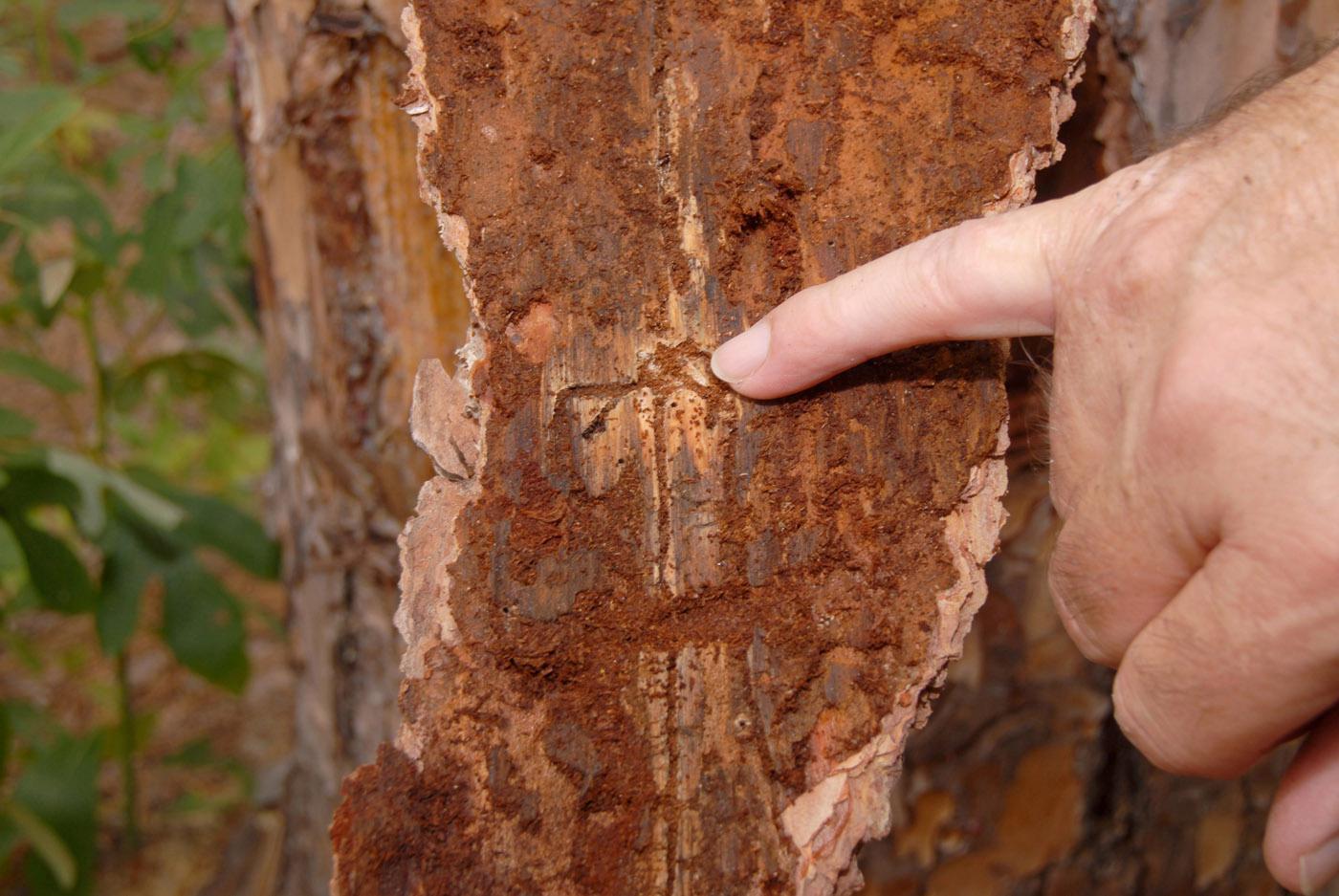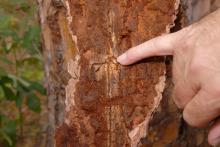Information Possibly Outdated
The information presented on this page was originally released on July 21, 2011. It may not be outdated, but please search our site for more current information. If you plan to quote or reference this information in a publication, please check with the Extension specialist or author before proceeding.
Pine bark beetles taking advantage of drought
MISSISSIPPI STATE – With most of the state needing rain and south Mississippi under exceptional drought, landowners are watching as their trees deal with stress.
Glenn Hughes, forestry professor with the Mississippi State University Extension Service, said dead or dying trees, both pine and hardwood, are becoming a common sight in south Mississippi. This concerns both homeowners and forest landowners.
“The drought is most severe in south Mississippi,” Hughes said. “It has weakened trees, making pines more prone to attack from bark beetles and killing hardwoods that are not drought-tolerant.”
Much of south Mississippi received significant rainfall recently, but for many trees, it came too late.
Based on data from the U.S. Drought Monitor, only the most northern 10 counties are without drought, although abnormally dry. All the remaining counties are in drought, classified as moderate, severe or extreme. The six coastal counties are in the worst drought classification.
Bark beetles become a problem when pine trees are stressed. The best defense is to keep the trees vigorous. Hughes said homeowners can provide irrigation for trees in their yards.
“You can water your trees once or twice a week during a drought period,” Hughes said. “Infrequent, deep watering is better than more frequent, less intense watering.”
But for those with timberland acres, there are not many options when drought sets in.
“The most effective prevention technique involves maintaining healthy pine trees,” Hughes said. “For forest landowners, this means thinning your trees at the appropriate time -- regardless of timber prices -- to reduce stress, which also reduces insect attacks.”
There is no effective chemical treatment to prevent a pine bark beetle infestation in a forestland setting and no reasonable chemical extermination method.
“Trees are a significant asset, so landowners and homeowners need to become familiar with the signs of infestation in order to identify, treat and stop the beetles,” Hughes said.
Signs of bark beetles include needles turning from dark green to yellowish green and then reddish brown and the appearance of globs of sap on the bark. The globs of sap are known as “pitch tubes” and indicate where a beetle has bored into the tree.
Andy Londo, Extension forestry professor, said the majority of the damage in Mississippi from pine bark beetles is caused by one of three kinds of Ips beetle found in the state. Two other bark beetles of concern in the state are the black turpentine beetle and the Southern pine beetle.
“When you have a problem with pine bark beetles, what you can do depends in part on what beetle is present,” Londo said. “We have not had a Southern pine bark beetle outbreak in Mississippi since 1995, and we are not expected to have one this year.”
Ips beetle numbers are expected to be high again, as they have been in recent years. Most cases of Ips beetles are not a cause for worry, he said.
“Their normal behavior is to kill a tree here and there, forming pockets of maybe 10 to 20 dead trees,” Londo said. “Treating for an Ips spot just isn’t an economical or viable option.”
Black turpentine beetles rarely kill trees, and they are found near the base of the tree from the ground line up to 3 or 4 feet.
“They are big and ugly, and they make pink-colored sawdust and pitch tubes, but they normally do not kill your trees,” Londo said. “If they’re there, it’s a sign that your tree is stressed, but there’s not a whole lot you can do about it.”
Southern pine beetle is the real threat. An outbreak causes major losses. For example, between 1999 and 2002, Tennessee lost about 300,000 acres of pine timber to the Southern pine beetle.
“If you have a Southern pine beetle spot forming, it is important to determine whether it’s an active or inactive spot,” Londo said. “Eighty to 85 percent of spots go inactive after a few trees are killed. These are a low priority. But the active spots must be controlled.”
A forester can help determine the type of beetle and the best course of action.
An Ips beetle attack usually causes parts of the crown die. If the whole crown changes from healthy green to yellowish and then reddish brown at the same time, the tree is probably under attack by the Southern pine beetle, Londo said.
Another way to identify the beetle is to pull back the bark from an infected tree and examine their trails, known as galleries.
“If they are linear in nature, they are Ips. Ips make straight or intersecting lines,” Londo said. “But if you pull off the bark and they are S-shaped galleries or squiggly lines, that’s a very clear indication it’s Southern pine beetles.”






